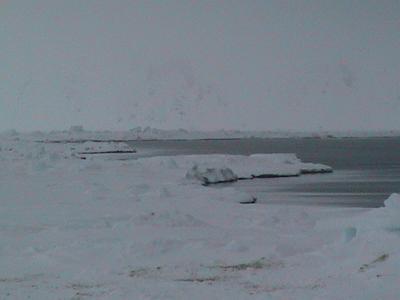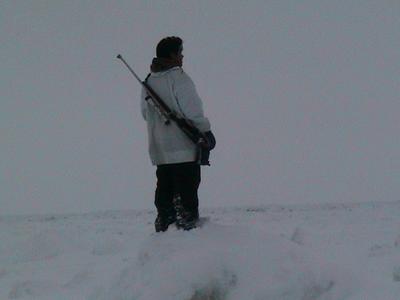2 April, 2003
Working on the Edge
Today the same three icekateers, Jerry, Jim and I,
were back on the ice drilling holes. Four holes were
augured today two each at the opposite ends of the
island where the ice is much thinner and meets the
open water.
The purpose for drilling so many holes on the ice
at various locations is to collect as much data as
possible. All of the data is compared it to the data
being collected in the science shack. As my sixth
graders know you never, ever, ever just take one
reading or sampling.
The weather was overcast, windy and unusually balmy
at 30 degrees F (with the wind the wind chill was
about zero degrees F).
We first traveled south as far as the ice would
safely allow and west as far as the International
Dateline to drill the first two holes. The ice was
much thinner here because it was newer. Changes in
wind direction can easily break these pieces away but
we were far enough away from the edge. The ice is also
much smoother here since it is newer and it has not
had the chance to be crumbled and pushed into piles
like the older ice.
Our second holes were to be drilled as far north as
possible. The ice was much thicker here and we were
able to walk right up to the edge where the ice and
open water meet. These open water areas are called
leads and can be as large as 100 miles long. These
areas are usually where all of the animal action takes
place. We spotted a number of gulls and ravens feeding
and small pieces of what could have been a leftover
polar bear kill, the distance was too far for us to be
sure. We also sited seal, referred to as oogruk here,
about 75 yards away but it quickly dove once it
spotted us.
The contrast between the water and the ice was a
refreshingly welcome site after four hours of seeing
varying tones of white and the potential for wildlife
sightings is great here. Fog quickly rolls in and once
our holes are drilled we head back. We will return to
all of our sites to collect samples and data on a
routine basis once all of the holes we need are
created.

Open lead at our nothern drill sites.

Our polar bear guard and snowmobile driver keeping watch.
Contact the TEA in the field at
.
If you cannot connect through your browser, copy the
TEA's e-mail address in the "To:" line of
your favorite e-mail package.
|
